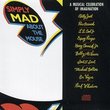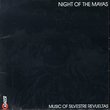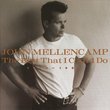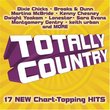| All Artists: Kenneth Schermerhorn, Nashville Symphony Orchestra Title: Howard Hanson: Orchestral Works, Vol. 1 Members Wishing: 0 Total Copies: 0 Label: Naxos American Release Date: 7/18/2000 Genre: Classical Styles: Opera & Classical Vocal, Forms & Genres, Theatrical, Incidental & Program Music, Historical Periods, Modern, 20th, & 21st Century, Symphonies Number of Discs: 1 SwapaCD Credits: 1 UPC: 636943907221 |
Search - Kenneth Schermerhorn, Nashville Symphony Orchestra :: Howard Hanson: Orchestral Works, Vol. 1
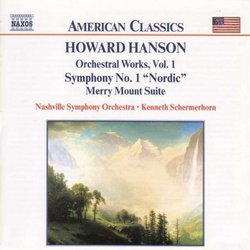 | Kenneth Schermerhorn, Nashville Symphony Orchestra Howard Hanson: Orchestral Works, Vol. 1 Genre: Classical
Naxos, the Little Label That Could, has emerged as the music industry's foremost advocate of American music with their American Classics series. Now, they've turned their attention to one of the greatest composers of Ameri... more » |
Larger Image |
CD DetailsSynopsis
Amazon.com Naxos, the Little Label That Could, has emerged as the music industry's foremost advocate of American music with their American Classics series. Now, they've turned their attention to one of the greatest composers of American Romanticism, Howard Hanson. This inaugural disc contains a performance of the First Symphony that easily trumps the Gerard Schwarz-Seattle Symphony on Delos. Hanson himself has recorded the work several times, but the Naxos release has much better sound quality (and you'll like the breadth of the Nashville Symphony's vision of this delicious music). The same holds for the celebratory "Merry Mount" Suite. However, this release contains two rare discmates, the symphonic poem Pan and the Priest and Rhythmic Variations on Two Ancient Themes. Spectacular music of undeniable character. --Paul Cook Similarly Requested CDs
|
CD ReviewsAn auspicious start to a new Hanson series Bob Zeidler | Charlton, MA United States | 11/14/2000 (5 out of 5 stars) "This is a terrific coupling of Howard Hanson's orchestral music, both well-known and barely-known. It is advertised as Volume I of his orchestral works, and, if Kenneth Schermerhorn and Naxos follow through with the rest of Hanson's orchestral works, this could result in a near-definitive essay of one of America's most important and beloved composers. Others, including Hanson himself, on Mercury Living Presence and Gerard Schwarz and the Seattle Symphony Orchestra on Delos, have recorded his central repertoire, including the symphonies and the larger orchestral works. But no series was ever completed; Hanson's own foray, with the Eastman-Rochester Orchestra, was cut short by his retirement from active conducting in the mid-'60's. So this is a very welcome start to what this Hanson fan hopes to be a complete essaying of the orchestral works. Basically conservative and an arch romantic, Hanson had been considered a "throwback" composer during much of his life, bypassing the avant garde, serialism, modernism, post-modernism, minimalism and all other "ism's" of the 20th century. But his music is immediately accessible and is characterized by a gift for melody, harmonic lushness and rich chromaticism reminiscent of Bruckner. Born of Swedish stock in Wahoo, Nebraska, his music comes naturally by its "Nordic" sense of place, with the symphonies and other works of Sibelius clearly in his musical DNA. But there are other identifiable musical "signatures" in addition to Sibelius and Bruckner: Hanson's frequent use of tympani ostinato in his symphonies recalls the opening bars of Brahms' 1st Symphony, and his often brilliant splashes of orchestra color, particularly high woodwinds, is a reminder that, after winning the American Prix de Rome in 1920, he studied under Ottorino Respighi while in Rome. (At the time, Respighi had only written "The Fountains of Rome," the first of three parts of his Roman triptych; "The Pines of Rome" and "Roman Festivals" were written after Hanson had returned to the U.S.) I will cheerfully go on record to state that Schermerhorn's performance of the "Nordic" Symphony is the best available, from the perspectives of interpretation, performance and recorded sound quality. (Hanson's would of course have been the definitive one, were the Eastman-Rochester Orchestra up to snuff, and had Mercury had the access to recording technology that is presently available.) With modestly careful listening, one can pick out all of the musical signatures noted above, yet still conclude that Hanson is his own man, with his own musical thoughts to express. Hanson's one opera, "Merry Mount," had been an instant success at its premiere, but has since languished in near-obscurity save for the orchestral suite which he fashioned from its incidental music. The "Love Duet" makes a strong case for a remounting of this opera; it is a gorgeous piece of music just waiting for the complete opera to surround it. "Pan and the Priest" is an early tone poem, making its recording premiere, as far as I know, in this coupling. It brings to mind several of the great tone poems written by Sir Arnold Bax, Hanson's British contemporary, as well as those of Hugo Alfvén, his Swedish contemporary. This is excellent company to be allied with, and it is our loss that Hanson did not write more works in this genré. Identifiably Hanson, it holds up very well in comparison with the the poems of Bax and Alfvén. "Rhythmic Variations on Two Ancient Hymns" also receives a recording premiere here. Modal in structure and feel, it is reminiscent of the simiarly modal music of Ralph Vaughan Williams. Spendid performances and recording of a great cross-section of Hanson's orchestral works. Like Schermerhorn's Ives Symphony No. 2 which came immediately after this Hanson disc, yet another American Classics triumph for Naxos, "the little label that could." Bob Zeidler" A New, Expansive View of Hanson's First Symphony Thomas F. Bertonneau | Oswego, NY United States | 11/13/2000 (4 out of 5 stars) "At the end of Ridley Scott's 1979 film "Alien," after Sigourney Weaver has at last defeated the eponymous creature by expelling him from the lifeboat's airlock, a music of marvelous relaxation suddenly dominates our awareness: It is the middle movement of Howard Hanson's (1896-1981) expansive Second Symphony, "the Romantic" (1930). Weaver's character is not, at that moment, aware of the impending sequels, so she is able to relax along with the spectators. Howard Hanson oddly resembles Scott's alien. He is a powerful presence whom his modernist nemeses have repeatedly attempted to expel, by declarations of his hopeless Romanticism and obsolescence, who nevertheless keeps reasserting himself to their great consternation. Good for him. The real alien presence is the cacophonic phalanx that seems, at long last, to have entered its final recession. As the atonal tide has ebbed, the mid-century Romantics have flooded into prominence once again, Hanson notably among them. In the dark days of dodecaphonic correctness, the Second Symphony alone betokened Hanson's stubborn persistence. But in the early 1970s, the old Mercury/Eastman Rochester Philharmonic recordings, with Hanson conducting his own music, became available again as Philips Golden Import LPs, some in stereo and some in reprocessed mono; and early in the CD era, Delos released Gerard Schwarz's traversal of Hanson, including all the symphonies, with the Seattle Symphony Orchestra, in digital sound. These recordings put Gerard Schwarz (formerly a baroque music specialist) on the star-map. Delos abandoned its American music series, but Naxos seems determined to pick up the slack. They have released the first of what promises to be a Hanson cycle. The disc in question features Hanson's First Symphony, "The Nordic" (1922), and three smaller works - the suite from the opera "Merry Mount" (1938), the tone-poem "Pan and Priest" (1925), and the "Rhythmic Variations on two Ancient Hymns" (an early undated work, probably from Hanson's Roman period). Kenneth Schermerhorn's competition in the First Symphony comes from Hanson himself, who recorded it in the 78 era and again in stereo in the late 1950s, and from Schwarz. Leading his Nashvillians, Schermerhorn takes a very broad view of the First, seeing it as a rehearsal for the Second of eight years later. Perhaps oddly, given the orchestra, this version of the First comes across as less definitively American than either the composer's own readings or Schwarz's. When Hanson wrote "The Nordic," he was Ottorino Respighi's student: That explains the pervasive modality, the pagan feeling, and even the occasional slightly Russian coloration (Respighi had studied with Rimsky-Korsakov). My vote is for Schermerhorn over the competition. He makes of this work a near-equal to the Second, or "Romantic," Symphony. Of the other scores, "Pan and Priest" constitutes the most important addition to the Hanson discography. Hanson takes his unstated inspiration, I imagine, from one of the "Idylls" of the Greek poet Theocritus: Pan is not the quaintly comic goatherd-god, but a terrifying force of nature whose annunciation provokes real awe. (So is he too in Mahler's Third Symphony or in Novak's immense tone-poem "Pan.") We feel the deity's intimidating presence in the music. The notes perpetrate a silly error: Hanson was born in Wahoo, Nebraska, not "Wahoo, New England." That aside, this is a promising first entry in Naxos' implied survey-to-come of the Hanson orchestral oeuvre." One of the best introductions to Howard Hanson's work Robert Badger | Philadelphia, PA | 06/12/2004 (5 out of 5 stars) "The late Howard Hanson was a man of many talents. He was a gifted conductor, an inspired composer, and one of the greatest educators in the history of American music.Unfortunately, like so many composers, Hanson's work became neglected. Hanson was an arch-romantic. His lush and romantic scores were written at the same time as Stravinsky was shocking Parisian audiences, as Copland and Thomson were stressing the importance of Americana, and as Henry Cowell was touring Europe and America with his music based on tone clusters. However, this is no reason to neglect Hanson's work.The Symphony No. 1 "Nordic" is one of my favourite Hanson works. The recording that the composer himself made of Mercury remains my favourite, though this version has quickly become a favourite as well. Maestro Schermerhorn has the advantages of a well trained ensemble. Schermerhorn is a gifted conductor and makes this work sound like what it actually is, one of the masterpieces of American music. The other works on the CD are no less interesting. In short, this is probably the best introduction to Hanson's work as a composer. One hopes that there will be many more Hanson CDs from Schermerhorn and the Nashville Symphony!"
|

 Track Listings (9) - Disc #1
Track Listings (9) - Disc #1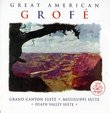
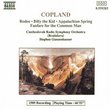

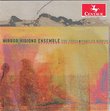
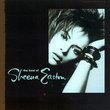
![The Ink Spots - The Greatest Hits [MCA]](https://nationalbookswap.com/cd//m/61/4061/24061.jpg)
